|
Cutthroat were native to the river, and probably rainbow, but
hatchery plantings have disturbed the tracing of genetic trout
heritage, particularly with rainbow.
There is a strong population of wild rainbow, with more numbers
of wild cutthroat in the lower river. The McKinzie hosts a small
but stable population of bull trout. Current regulations
[as of 1996] require that all wild trout be returned to the
McKenzie River unharmed. McKenzie trout average 8 to 14
inches, with some going 16 inches, and an occasional fish 18
inches or better. Many of the larger rainbows exhibit the same
dark coloration and deep red stripe that Deschutes rainbow do,
and proudly bear the same moniker, "redside". However, the
McKenzie is not a trophy trout river.
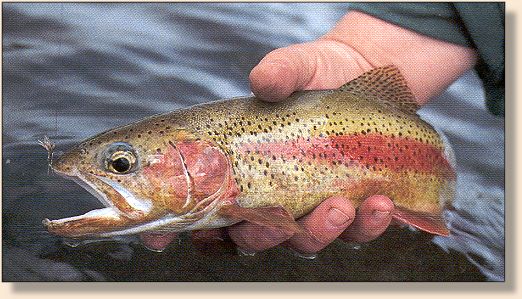
Steelhead in any number are not native to the McKenzie, although
it's possible these migratory rainbow established remnant colonies
because steelhead go upriver to spawn, instituting new runs in an
evolutionary fashion. Since biologists estimate that some 400 to
1,000 steelhead now spawn in the wild in the McKenzie system,
we can guess that eons ago there may have been some native
steelhead in the McKenzie watershed, although whether they
could negotiate the Willamette Falls is unknown. From a yearly
release of 108,000 smolts, there is now a modest hatchery summer
steelhead run of 2,000 to 3,000 adult fish that spend two years
in the ocean and run from 7 to 9 pounds, with an occasional
three-salt fish that weighs 12 to 13 pounds. While some continue
upstream and spawn in the McKenzie system, most pause at
Leaburg Dam, which is somewhat logical because these fish
originate at Leaburg Hatchery.
The McKenzie is a classic Pacific Northwest semi-rainforest river,
cloaked in fir and hemlock, swatted with rain much of the fall, winter
and spring. It runs blue-green in its upper stretches where the river
canyon squeezes tumbling runs between boulder strewn pockets;
the lower river below Hayden Bridge is flatter, but can still trick
the unwary.
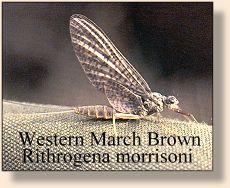 The McKenzie runs close to civilization; the cities of Springfield
and Eugene house over 100,00 people; access via 1-5 is a quick
springboard to her waters. From the March Brown hatch on
through the season, the lower river is often excessively loved by
its admirers on foot and in floating craft; the water in the upper
river is continually churned with oars in the sunshine months.
You can still get away from people, but it will take some effort
on your part - you may want to avoid peak times and the more
popular sports on the river. [For a MAP of the McKenzie River
region, click here.]
The McKenzie runs close to civilization; the cities of Springfield
and Eugene house over 100,00 people; access via 1-5 is a quick
springboard to her waters. From the March Brown hatch on
through the season, the lower river is often excessively loved by
its admirers on foot and in floating craft; the water in the upper
river is continually churned with oars in the sunshine months.
You can still get away from people, but it will take some effort
on your part - you may want to avoid peak times and the more
popular sports on the river. [For a MAP of the McKenzie River
region, click here.]
In many places the river veers from public access, making extensive
stretches of the McKenzie a boater's river. While there are miles of
river that are navigable with only moderate boating expertise, many
sections are dangerous, even to skilled boaters. Public access offers
fishing opportunities at numerous boat launches, parks, Willamette
National campgrounds, and along the McKenzie River National
Recreation trail.
The portion of the McKenzie below Hayden Bridge is open to
year-round fly fishing, barbless hooks; the remaining waters open
the fourth Saturday in April and close October 31. Hatchery catchable
rainbow are stocked in the South Fork McKenzie above Cougar
Reservoir and in the middle portion of the main McKenzie from
Paradise Campground to Hayden Bridge. The river above Paradise
Campground is not stocked, barbless fly and lure only. An additional
steelhead season extends to December 31, furthering legal fly fishing
for steelhead and whitefish up to the deadline just below Leaburg Dam.
January and February on the River
Trout fishing on the McKenzie in these winter months is legally
open from Hayden Bridge downstream, but your success is totally
dependent on water level and clarity. Typically the river is up some,
with water temperatures in the low 40s. If the river is clear you may
encounter Blue Wing Olive hatches in the early afternoon, matched
with size 18 and 20 dries and emergers. The winter stoneflies
occasionally hatch in February, and trout and whitefish do take
them, but it's sporadic.
This probably won't come as a surprise: you'll catch most of your
fish this time of year by nymphing the riffles and throats of the runs.
One word of caution though: don't charge into the river, wading
out and pitching your nymph setup into deep water - you'll wade
right through feeding fish.
. . . Successful nymphs include the Hare's Ear in natural tan, a darker
brown version, or olive, the Red Fox Squirrel Nymph, Soft Hackle,
and Pheasant Tail in sizes 10 to 14. Some nymph fishers prefer to
watch the end of their brightly colored floating fly line to detect the
strike, but some type of fluorescent strike indicator greatly aids
most of us.
Of course, then there are those wonderful afternoons when everything
seems to be to the liking of insects and trout, Blue Wing Olive
(Baetis) mayflies hatch, trout rise, and you're
on the stream. Tactics are the usual for dry fly: a nine - or ten-foot
leader tapered down to two or three pound test (with a nice long
springy tippet of two or three feet long); a size 18 or 20 Adams,
Adams Parachute, or Blue Wing Olive Comparadun, dead-drifted
over the trout's feeding station. [For the FLIES for the McKenzie River,
click here.]
Spring on the McKenzie
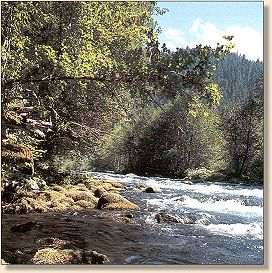 Spring announces herself with swallows sifting the air for insects;
the swallows migrate from warm southern climates, the insects
migrate from their aquatic homes to emerge as creatures of land
and air. When swallows arrive mid-March they may find a hatch
of Blue Wing Olive mayflies, size 18 or 20, or they may dine on
hatching Western March Brown mayflies.
Spring announces herself with swallows sifting the air for insects;
the swallows migrate from warm southern climates, the insects
migrate from their aquatic homes to emerge as creatures of land
and air. When swallows arrive mid-March they may find a hatch
of Blue Wing Olive mayflies, size 18 or 20, or they may dine on
hatching Western March Brown mayflies.
The Western March Brown will hatch on sunny days, but they
prefer overcast, misty or light rain days, which seems to make
sense because the McKenzie has many of those days, particularly
in the spring. In fact, the hatches are sparse on bright spring days,
but can be glorious on soggy wet river rat days when only the
devoted are on the river. River height and clarity only seems to
affect dry fly fishing and the predilection for trout to take the duns,
and dry flies. Some of the most intense hatches occur when the
river is high and off color, too brown to fish but not too chocolate
for March Browns.
The second important hatch is also a toothsome insect for trout,
the McKenzie Caddis, size 10, with gray wings and an iridescent
blue-green body . . . This robust caddis begins hatching in late
April, tapering off in June . . .Because the hatch stretches out
several weeks, trout key in on this caddis, eagerly pouncing
on the naturals.
Summer on the McKenzie
One of the first mayflies of early summer hatches is a fluorescent
yellow size 14 dun that almost glows in low slanting sun. Interestingly
enough, although juvenile fish and sometimes whitefish rise to this
bug - which often results in a dampened but still floating
insect - adult trout seem to disdain this mayfly. At times I've
had good success with a size 14 bright yellow Comparadun
on the Santiam River, so maybe others have done well on the
McKenzie by matching this hatch.
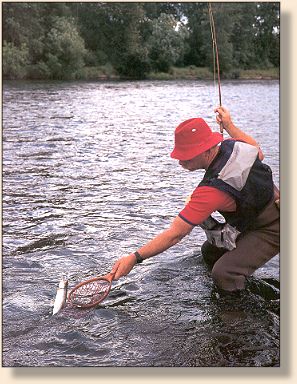
I've had more success matching the more prevalent size 14 and 16
cream mayflies . . .with cream Comparaduns, Parachutes, or a
favorite traditional, the Light Cahill. The Cahill is excellent for
simulating a variety of cream bugs that hatch during the summer;
besides the pale mayflies, the Cahill can pass for pale caddis or
the Little Yellow stonefly.
When fly fishers talk about summer hatches, it's common to hear
the "PMD" code word bouncing off the pegboard canyons of
fly shops throughout the West, including those that service the
McKenzie . . . The PMDs on the McKenzie are light brown or
creamish-brown, usually close to a size 16. Water and air
temperature, as well as water depth and clarity determines the
timing of the hatch, which starts in June and continues until it
compresses down to the last bit of daylight during the hot weeks
of late summer. . . However, during the heat of summer you might
want to consider some alternatives to fishing the main river, such
as in the High country.
Fall on the McKenzie
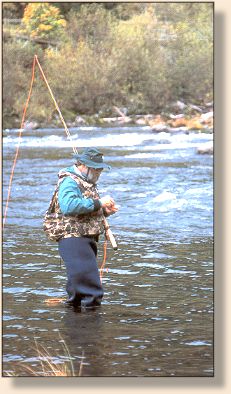 Although the calendar may indicate that fall is here, the first of
September finds the McKenzie Valley still wrapped in summer's
clutches, with warm nights and hot days, which continue until
the first cooling autumnal rains hit around the third week in
September.
Although the calendar may indicate that fall is here, the first of
September finds the McKenzie Valley still wrapped in summer's
clutches, with warm nights and hot days, which continue until
the first cooling autumnal rains hit around the third week in
September.
The first major hatch of the late season is the Fall Caddis
(Limnephilidea discomoecus), a size 8 rusty
orange caddis that provokes the larger redsides to the top,
especially on overcast days . . . However, on the upper
McKenzie this caddis begins hatching during the first part
of September.
You might bear in mind that a modest run of Chinook salmon
glides upriver about mid-September. These fish have traveled
some 200 miles in freshwater, and as such are not bright fish
and should be allowed to spawn without harassment from fly
fishermen. However, trout don't overlook the fact that while
spawning, some salmon eggs drift loose in the current, offering
a tasty snack for rainbow and cutthroat holding just downstream.
With micro eggs and a weight on the leader you can catch trout
by easing your fake egg downstream from the salmon without
disturbing their spawning.
Fall Steelheading
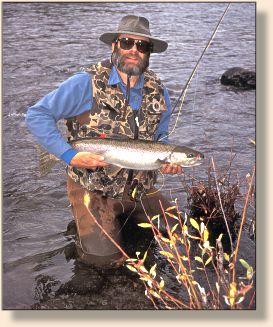
The McKenzie summer steelhead are Skamania stock hatchery
raised at the facility at Leaburg. The run is sustained by a yearly
release of 108,000 adipose-fine-clipped smolts.
November
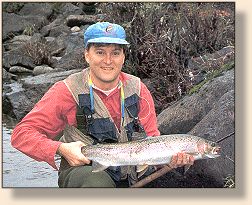 November 1st marks an important change in available fishing
waters on the McKenzie: the river is only open from the Leaburg
Dam downstream. You can fly fish for steelhead and whitefish
from there down to Hayden Bridge; from Hayden to the mouth,
it's open for steelhead, whitefish, and catch-and-release trout
fishing.
November 1st marks an important change in available fishing
waters on the McKenzie: the river is only open from the Leaburg
Dam downstream. You can fly fish for steelhead and whitefish
from there down to Hayden Bridge; from Hayden to the mouth,
it's open for steelhead, whitefish, and catch-and-release trout
fishing.
The McKenzie is certainly not a world class steelhead fishery,
and it's certain that you won't always catch steelhead on the
McKenzie. But if you do go out on the river, you'll raise your
odds of catching a fish considerably more than your zero
changes if you stay home.
December - A Year's End
This time of year McKenzie trout don't overlook the fact that
Mountain whitefish or Rocky Mountain whitefish . . . spawn in
December. When trout spawn, they build a nest among small
well aerated rocks on the river bottom; whitefish simply broadcast
their eggs, allowing the eggs to cling to the rocks via a sticky
mucous that covers the eggs. Some eggs don't adhere to the
bottom, but drift free in the current, offering a ready meal for
hungry trout. Also, while trout spawn primarily in riffles,
whitefish spawn in gravel flats and tailouts, as well as riffles,
which expands the trout egg-feeding territory.
Some Decembers in the McKenzie valley are mild, resulting in
lower than usual water flows, extending the fly fishing season
on through the end of the year. Normal Decembers, however,
soon bring cold rain or snow, water temperatures drop and the
river comes up, limiting the number of fishable days in the month.
Nevertheless, you can steal days from daily life, slipping away
to the Mother McKenzie to fly fish for an afternoon, even
though it's just for a few fleeting hours.
The End of the Season
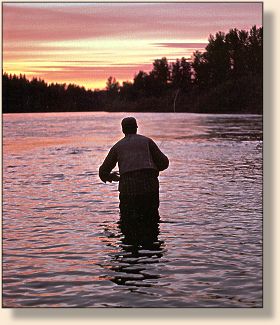 Fishing days are few in December, though fishermen always look
to the 'morrow, when the river is "in shape" and hatches bring trout
to feed. But December is the time to remember the season past,
read books, build rods, and tie flies.
Fishing days are few in December, though fishermen always look
to the 'morrow, when the river is "in shape" and hatches bring trout
to feed. But December is the time to remember the season past,
read books, build rods, and tie flies.
December is a time of musing, a speculation on the year as a
circle of time, another year we witness the carousel of seasons,
the comings and goings of birds, aquatic insects, cold, heat,
rain and snow, and our own mingling with the river. I know
that someday I will die, and that my bones will turn to dust,
not that much unlike the volcanic dust that forms the riverbed
that cradles the McKenzie. And as such, I will be a part of the
river, Just as much as I am a part of the river when I fish it.
I like being a part of the McKenzie, and a fly rod is a great
way to be there. ~ Deke Meyer
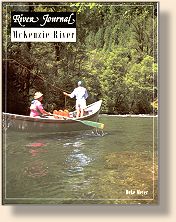 For a MAP of the McKenzie River, click
here.
For a MAP of the McKenzie River, click
here.
For the FLIES for the McKenzie River click
here.
To ORDER McKenzie direct from the publisher, click
HERE.
Credits: From the McKenzie River, part of the River
Journal series, published by
Frank Amato Publications.
We greatly appreciate use permission.
|



 Spring announces herself with swallows sifting the air for insects;
the swallows migrate from warm southern climates, the insects
migrate from their aquatic homes to emerge as creatures of land
and air. When swallows arrive mid-March they may find a hatch
of Blue Wing Olive mayflies, size 18 or 20, or they may dine on
hatching Western March Brown mayflies.
Spring announces herself with swallows sifting the air for insects;
the swallows migrate from warm southern climates, the insects
migrate from their aquatic homes to emerge as creatures of land
and air. When swallows arrive mid-March they may find a hatch
of Blue Wing Olive mayflies, size 18 or 20, or they may dine on
hatching Western March Brown mayflies. Although the calendar may indicate that fall is here, the first of
September finds the McKenzie Valley still wrapped in summer's
clutches, with warm nights and hot days, which continue until
the first cooling autumnal rains hit around the third week in
September.
Although the calendar may indicate that fall is here, the first of
September finds the McKenzie Valley still wrapped in summer's
clutches, with warm nights and hot days, which continue until
the first cooling autumnal rains hit around the third week in
September.
 November 1st marks an important change in available fishing
waters on the McKenzie: the river is only open from the Leaburg
Dam downstream. You can fly fish for steelhead and whitefish
from there down to Hayden Bridge; from Hayden to the mouth,
it's open for steelhead, whitefish, and catch-and-release trout
fishing.
November 1st marks an important change in available fishing
waters on the McKenzie: the river is only open from the Leaburg
Dam downstream. You can fly fish for steelhead and whitefish
from there down to Hayden Bridge; from Hayden to the mouth,
it's open for steelhead, whitefish, and catch-and-release trout
fishing.
 The McKenzie runs close to civilization; the cities of Springfield
and Eugene house over 100,00 people; access via 1-5 is a quick
springboard to her waters. From the March Brown hatch on
through the season, the lower river is often excessively loved by
its admirers on foot and in floating craft; the water in the upper
river is continually churned with oars in the sunshine months.
You can still get away from people, but it will take some effort
on your part - you may want to avoid peak times and the more
popular sports on the river. [For a MAP of the McKenzie River
region, click
The McKenzie runs close to civilization; the cities of Springfield
and Eugene house over 100,00 people; access via 1-5 is a quick
springboard to her waters. From the March Brown hatch on
through the season, the lower river is often excessively loved by
its admirers on foot and in floating craft; the water in the upper
river is continually churned with oars in the sunshine months.
You can still get away from people, but it will take some effort
on your part - you may want to avoid peak times and the more
popular sports on the river. [For a MAP of the McKenzie River
region, click 
 For a MAP of the McKenzie River, click
For a MAP of the McKenzie River, click